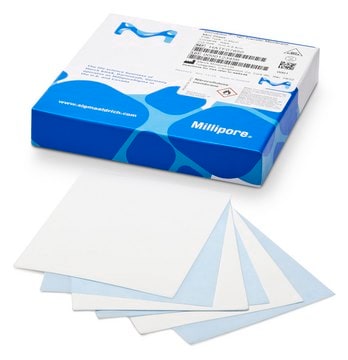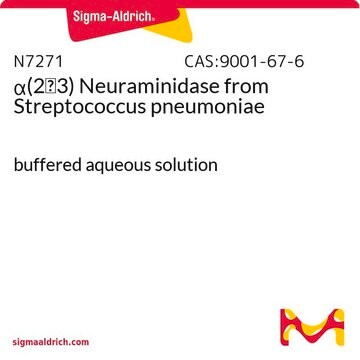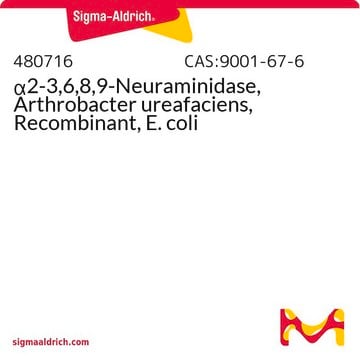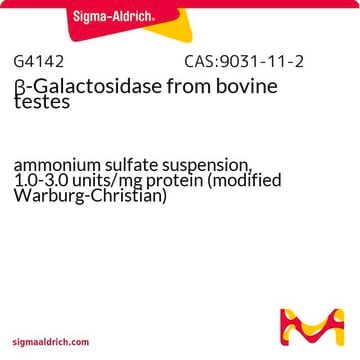11585886001
Roche
Neuraminidase (Sialidase)
from Clostridium perfringens
Synonym(s):
Sialidase
Sign Into View Organizational & Contract Pricing
All Photos(1)
About This Item
Recommended Products
biological source
bacterial (Clostridium perfringens)
Quality Level
form
lyophilized
specific activity
100 U/mg
~100 units/mg protein
mol wt
60 kDa
packaging
pkg of 5 U
manufacturer/tradename
Roche
optimum pH
5
shipped in
wet ice
storage temp.
2-8°C
General description
approximately 100 U/mg protein at +37°C and pH 5.0 with N-acetyl-neuraminosyl-D-lactose as the substrate.
Specificity
Cleaves terminal sialic-acid residues that are α2,3-, α2,6-, or α2,8-linked to Gal, GlcNAc, GalNAc, AcNeu, GlcNeu, oligosaccharides, glycolipids, or glycoproteins. Relative rate of cleavage is α2,3 >α2,8 = α2,6, determined on bonds in tri- and tetrasaccharides.
Application
Neuraminidase (Sialidase) has been used to desialylate transferrin in order to study its isoforms in human serum.
Use Neuraminidase to hydrolyze terminal N- or 0-acylneuraminic acids which are α2,3-, α2,6-, or α2,8-linked (rate α2,3: > α2,6 = α2,8) to oligosaccharides, polysaccharides, mucopolysaccharides, glycoproteins, and glycolipids.In contrast to the enzyme from Arthrobacter ureafaciens, neuraminidase from Clostridium perfringens hydrolyzes α2,3-linkages faster than α2,6-linkages. α2,8-bound sialic acids area cleaved with a similar velocity compared to α2,6-bound sialic acids.
Neuraminidase is used for:
Neuraminidase is used for:
- Virus receptor studies
- Studies on the interaction of lymphocytes with tumor cells
- Cell hybridizations
- Analysis of oligosaccharides
- Analysis of glycoproteins
- Analysis of glycolipids
Biochem/physiol Actions
Neuraminidase breaks α-ketosidic linkage between N-acetylneuraminic acid and the adjacent sugar residue.
Neuraminidase mediates apoptosis in the host cell before viral entry.
Preparation Note
Stabilizers: The enzyme can be stabilized by bovine serum albumin (BSA).
Storage conditions (working solution): After reconstitution in double-dist. water or sample buffer, the enzyme is stable for several weeks, stored at 2 to 8 °C; for longer storage, freezing is recommended. A stock solution may be made (e.g., at c = 5 U/100 μl). The enzyme looses approx. 50% of its activity after incubation at 37 °C for 24 hours.
Storage conditions (working solution): After reconstitution in double-dist. water or sample buffer, the enzyme is stable for several weeks, stored at 2 to 8 °C; for longer storage, freezing is recommended. A stock solution may be made (e.g., at c = 5 U/100 μl). The enzyme looses approx. 50% of its activity after incubation at 37 °C for 24 hours.
Other Notes
For life science research only. Not for use in diagnostic procedures.
Storage Class Code
11 - Combustible Solids
WGK
WGK 1
Flash Point(F)
does not flash
Flash Point(C)
does not flash
Certificates of Analysis (COA)
Search for Certificates of Analysis (COA) by entering the products Lot/Batch Number. Lot and Batch Numbers can be found on a product’s label following the words ‘Lot’ or ‘Batch’.
Already Own This Product?
Find documentation for the products that you have recently purchased in the Document Library.
Customers Also Viewed
Role of neuraminidase in influenza virus-induced apoptosis.
Morris S J, et al.
The Journal of General Virology, 80(1), 137-146 (1999)
Jesús S Aguilar Díaz de León et al.
Journal of Cancer, 12(16), 4993-5004 (2021-07-09)
Elevated concentrations of circulating low density lipoprotein (LDL) that is abnormally oxidized and desialylated is both a precursor to and a hallmark of atherosclerosis. Peripheral blood mononuclear cells (PBMCs) treated in vitro with interleukin-2 (IL-2) become lymphokine activated killer (LAK)
Jitka Caslavska et al.
Journal of separation science, 40(11), 2488-2497 (2017-04-04)
Capillary electrophoresis analysis of transferrin in human serum is used to assess genetic variants after desialylation with neuraminidase and iron saturation to reduce the complexity of the transferrin pattern and thus facilitate the recognition of transferrin polymorphisms. Asialo-transferrin forms are
Ryan Septa Kurnia et al.
Veterinary world, 15(8), 1896-1905 (2022-11-01)
Clostridium toxins are widely used as medicinal agents. Many active metabolic enzymes, including sialidase (neuraminidase), hyaluronidase, and collagenase, contribute to the mechanism of action of these toxins. Sialidase from Clostridium perfringens recognizes and degrades sialic acid receptors in the host
Y A Shtyrya et al.
Acta naturae, 1(2), 26-32 (2009-07-01)
The structure of the influenza virus neuraminidases, the spatial organization of their active site, the mechanism of carbohydrate chains desialylation by neuraminidase, and its role in the influenza virus function at different stages of the viral infectious cycle are considered
Our team of scientists has experience in all areas of research including Life Science, Material Science, Chemical Synthesis, Chromatography, Analytical and many others.
Contact Technical Service








